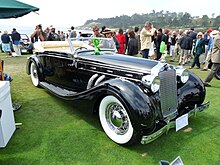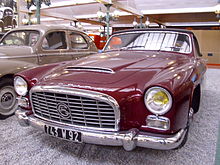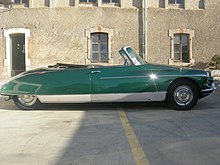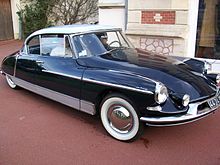Henri Chapron's studio
| Henri Chapron's studio
|
|
|---|---|
| legal form | |
| founding | 1919 |
| resolution | 1985 |
| Reason for dissolution | insolvency |
| Seat | Levallois-Perret |
| management | Henri Chapron |
| Branch | Body manufacturer |
Ateliers Henri Chapron was a French bodywork manufacturer based in Levallois-Perret near Paris . The company was founded in 1919 by Henri Chapron (born December 30, 1886 in Nouan-le-Fuzelier , † May 14, 1978 in Paris). In the period before World War II , Chapron was the preferred bodywork supplier for Delage and Delahaye ; In the post-war period, the company achieved fame above all for its special bodies for the Citroën DS , which include various convertibles. The company featured a stylized capon in its coat of arms . From 1920 to 1985 Chapron produced more than 10,000 vehicle bodies.
Company history
In March 1919, Henri Chapron founded Ateliers Henri Chapron, which began operations in the autumn of 1920. It was initially located in the Paris suburb of Neuilly-sur-Seine ; In 1923, Chapron relocated to neighboring Levallois-Perret , where the company moved into larger halls designed by Gustave Eiffel . In the first few years, the company dealt with equipping military vehicles from the First World War with bodies that made civil use possible. From 1923, Chapron bodyworked used and new Ford Model T chassis with standardized coupé and torpedo bodies. A little later, Chapron began producing superstructures for Delage. By 1927 the company had grown so much that Chapon had 340 employees and was delivering three vehicles a day. As a result of the global economic crisis, the number of employees fell by around half at the beginning of the 1930s, but grew again to the previous level in the following years. A business presence in Great Britain also contributed to this, which was secured via the Delage importer in London. In 1935, Chapron signed a contract with Delahaye, which secured the existence of his company in the medium term: In the future, Delahaye offered the largely standardized bodies manufactured by Chapron as factory superstructures. In particular, Chapron's bodies for the Delahaye 135 proved to be a success. In addition to the small series structures, Chapron continued to manufacture individual individual bodies at the customer's request. Here, too, the focus was on chassis from French manufacturers.
During the Second World War, Chapron completely stopped manufacturing car bodies. Immediately after the start of the war, Chapron had numerous incomplete vehicles as well as sheet metal parts and tools transferred to his place of birth in the central French region of Sologne , where they were hidden in various cellars for the next few years.
After the end of the war, Chapron resumed production in the old factory facilities. The company, like its competitors, had to struggle with changing circumstances. This included, among other things, France's economic weakness in the early post-war years, due to which the demand for exclusive luxury vehicles was very limited. It is true that Chapron made after such coupé and convertible bodies for Delage and Delahaye; the volume of pre-war production was no longer reached. Delage and Delahaye completely stopped automobile production in 1953 and 1957, respectively; a connection to Hotchkiss or Grégoire Sport was also not permanent. The change of car manufacturers to self-supporting bodies in the course of the 1950s made Chapron's work even more difficult, as they set narrow limits for individual bodies. Like Letourneur et Marchand, Chapron turned to the production of special versions of the Renault Frégate at this time ; In addition, there were numerous individual orders from domestic and foreign customers.
Only with the market launch of the Citroën DS did Chapron regain a secure order situation. On the one hand, Chapron manufactured a standardized cabriolet version of the "Déesse" on a factory order from 1960 to 1972, which was sold through Citroën dealers. In addition, numerous independent body versions were created, including two and four-seater convertibles and coupés as well as four-door sedans. By producing DS modifications, Chapron was able to generate profits until 1970. When DS production was phased out at the beginning of the 1970s, Chapron's production also collapsed. At the same time, the now 86-year-old Henri Chapron withdrew from the company. In 1972 his second wife Françoise took over the management of the company. It did not succeed in replacing the "Déesse" versions in an economically resilient manner. Chapron made some convertible and sedan versions of the new Citroën SM ; Despite the fact that they caused quite a stir, they remained unique. After Henri Chapron's death in 1978, the company still manufactured a few open or extended versions of the Citroën CX and the Peugeot 604. However, the focus was now on the repair of classics, on the armoring of series vehicles and on the installation of higher-quality interior fittings. The company could not be sustained in this way. In 1985 the ateliers Henri Chapron were closed due to bankruptcy.
The style of Chapron
Henri Chapron himself designed only a few of the bodies of his company. Marcel Devarenne was Chapron's designer since the late 1920s. In the early post-war period, it was primarily Carlo Delaisse who designed the Chapron bodies, who had previously been chief designer at Letourneur et Marchand . In the pre-war period, Chapron's designs were considered elegant and reserved; they stood out from the expansive, baroque forms of the competitor companies Saoutchik and Figoni & Falaschi ; In addition, the craftsmanship was considered to be of high quality. Chapron competed stylistically with Vanvooren and A. Guilloré . These plants had a comparable customer base, but had lower production capacities than Chapron. The Cannes- based Carrossier Brandone imitated the Chapron lines in some of its bodies, which were intended for customers on the Côte d'Azur .
Model history
Delage
Since 1923, Chapron has been producing bodies for Delage, a French manufacturer of luxury automobiles. The Delage Type D.8 presented in 1929 was of particular importance . Until the late 1930s, Chapron designed various convertibles, coupés and limousines, which at least at times were officially sold through Delage dealers. In the early 1930s, Chapron tried to stretch the bonnet optically for many designs in order to give the impression of particular sportiness. For this purpose, conspicuous ventilation openings were provided on the sides of the bonnets, some of which reached as far as the front stop of the doors. Chapron's bodies for the D8 received awards at several exhibitions.
In addition to the main cladding of Delage and Delahaye chassis, Chapron also produced individual bodies for Talbot , Hotchkiss and Hispano-Suiza in the 1930s . In 1934 he first produced a state car for French President Albert Lebrun .
Grégoire Sport
Between 1956 and 1962 the company manufactured some bodies for the Grégoire Sport .
The Grégoire Sport was a technically ambitious front-wheel drive project by the French engineer Jean-Albert Grégoire, which was based on a design from 1947 ( Grégoire R ). A series version was marketed by Hotchkiss from 1949 under the name Hotchkiss-Grégoire . The Grégoire Sport was a further development of this model, which Jean-Albert Grégoire sold under his own name. The body for the Grégoire Sport was designed by Chapron's designer Carlo Delaisse. Because the engine was positioned far forward, the vehicle had an unusually long front overhang for the time, which Dalaisse tried to conceal with a large radiator grille. The first prototype was made in January 1956; it was scheduled for an auto show in Detroit . Before being shipped to the US , the prototype was severely damaged in a serious accident on a public road in France. Chapron managed to rebuild the body in time for the exhibition within three weeks.
The very expensive Gregoire Sport was not an economic success. Only a few copies were made in the next few years. Some sources assume a total of five vehicles - four convertibles and one coupe - while others assume production of 10 to 15 cars.
Special bodies for the Citroën DS
After the war, a close collaboration with Citroën developed. On the basis of the Citroën DS (Déesse), which appeared in 1955 and was revolutionary at the time, Chapron developed and manufactured convertible versions from 1958, which were initially sold exclusively under its own name. In the course of time, different coupé versions and individual sedans based on DS were added. From 1961 onwards, Chapron finally also manufactured the so-called factory convertibles ( Cabriolets Usines ) on behalf of Citroën , which were sold through the Citroën dealer network and differed in numerous details from Chapron's own convertibles. In all cases, the forms of the conversions go back to Carlo Delaisse. The factory cabriolets were standardized and technically and stylistically followed the respective series versions of the DS sedan. Chapron's own convertibles, on the other hand, were individually designed in the area of the passenger cell and the rear end and took into account - albeit within limits - customer requests. The Usines convertibles achieved significantly larger numbers than Chapron's own models; about 110 Chapron convertibles are compared to more than 1,300 convertibles Usines .
Usine convertible
The official cooperation with Citroën began in 1961. On the basis of a design by DS designer Flaminio Bertoni, Chapron developed a two-door convertible body that was sold through the Citroën dealer network. By 1971, 1,365 copies of this type had been produced.
The factory convertibles used a DS platform supplied by Citroën, which included all of the mechanics, front fenders, windshield and wheels. Chapron used the full chassis, but reinforced various elements in the floor area. The doors of the standard sedan have been lengthened by 18 cm; Chapron remade the rear fenders. The factory cabriolets took over - unlike the own convertibles marketed by Chapron itself - the windshield of the production model in the same height.
Chapron convertibles
In addition to the factory convertibles, which have changed little over the years, Chapron continued to produce its own convertibles based on DS, which were designed independently and differed from the factory convertible in terms of both the roof structure and the rear end. Unlike the factory convertibles, Chapron usually used a six centimeter lower windshield for his own models ; however, the standard high windscreen was also used on some of the models at the customer's request. Chapron had its own windows manufactured for its models until 1964, after which the standard windshields were shortened by simply cutting them off. About a quarter of the discs were irreparably damaged in this process. Between 1958 and 1970, around 120 pure Chapron convertibles were produced in five series, which were available in different versions:
La Croisette
La Croisette was a four-seater convertible that was produced from 1958 to 1962. The model name referred to the Promenade de la Croisette in Cannes in the south of France .
The Croisette was Chapron's first DS convertible. It was first presented at the Paris Motor Show in October 1958. The front doors were slightly elongated, the shortened rear doors were welded shut. In the first examples, the gap between the (locked) rear doors and the fender was clearly visible; from 1959 it was covered with a vertical chrome strip. This ensured that the rear fenders could still be removed in the event of a tire change. It was not until 1960 that the rear fender was one-piece and without a joint. Chapron adopted a design feature that he had recently introduced for the factory convertible. The tire change was made possible in this case by enlarged wheel openings compared to the production version. The Croisette was produced in two series. The first series (1958/1959) was made in 25, the second (1960–1962) in 27 copies. The closed counterpart to the Croisette is the Coupé Le Paris.
Palm Beach
The Palm Beach replaced the Croisette from 1963. The predecessor was a full four-seater convertible. Unlike the Croisette and the Convertible Usine, the Palm Beach had two rear side windows and a narrower hood. The side windows - including the rear ones - could be lowered manually or electrically, depending on the design, so that the impression of a hardtop was created when the top was closed. The trunk line in the early years corresponded to that of the series DS; from 1964 the Concorde had stylized rear wings. In the course of the further development of the standard DS, the Palm Beach also took over its front design, including the steering headlights and the recessed door handles. The Palm Beach remained in production until 1970. A total of 30 copies were created in three series.
Le Caddy
The Le Caddy presented in 1960 was a 2 + 2-seater convertible version of the DS. The external dimensions corresponded to the standard sedan and the Cabriolet La Croisette. In the Le Caddy, however, the rear seat bench was moved far forward so that the roof could be cut more tightly. Le Caddy was in production until 1968. The model made all the technical and external changes of the series DS. Chapron manufactured a total of 34 vehicles of this type. The closed counterpart of the Le Caddy was the Coupé Le Dandy.
Coupes
In parallel to the convertibles, Chapron also offered a number of different coupés based on the DS, stylistically based on the convertibles. The following versions were created:
Le Paris
The Le Paris was the first coupé that Chapron realized on the DS basis. As a fully four-seater vehicle, it was the closed counterpart to the Cabriolet Croisette . The Le Paris had a fixed hard top. The rear sides were glazed; the panes could not be lowered. The C-pillar was in the shape of a triangle. The rear window was designed as a panoramic pane; it was made exclusively for Chapron. The design of the rear fenders followed that of the Cabriolet Croisette: In the first models, the gap between the welded rear door and the fender was clearly visible; later it was covered by a wide chrome strip. Chapron presented the Le Paris publicly at the Paris Motor Show in October 1958. The model remained on offer until 1960. During this time nine copies of Le Paris were made. In 1959 the vehicle cost 798,000 old French francs . Its successor was the outwardly very similar Concorde.
Concorde
The Coupé Concorde presented in 1960 was named after the Place de la Concorde located in the center of Paris . It was the successor to Le Paris. It corresponded conceptually and technically to its predecessor, so it also had four full seats. The roof line had been redesigned: Instead of the rounded structure of Le Paris, the Concorde had a narrow, straight C-pillar, the angle of which varied slightly over the years. The window area in the rear area was significantly larger than its predecessor. In the first few years, the trunk line was the same as that of the series DS; from 1964 the Concorde - parallel to the Palm Beach Cabriolet - had stylized rear wings. 38 copies were made by 1967.
Le Léman
The Le Léman coupé named after Lake Geneva appeared in 1966. Initially, the Léman stood next to the Concorde; after production was discontinued in 1967 and 1968, respectively, it was Chapron's only remaining DS coupé. Like the Concorde, the Léman was a four-seater coupé, but had a significantly more sloping C-pillar in comparison. Like the Concorde, the Léman also took over the new front section of the DS in the autumn of 1967 with glazed headlights, some of which were steering. The vehicle was equipped with small fins at the rear from the start. At the customer's request, a single example from the last year of production was given a straight rear section that corresponded to that of the Lorraine sedan; it had taillights from the Peugeot 204 . Chapron made 25 copies of Le Léman.
Le Dandy
Le Dandy (1960 to 1968): The Le Dandy, which had been using a model designation used by Chapron since the 1930s, was a 2 + 2-seater coupé. Unlike Chapron's other coupé versions, Le Dandy had no rear side windows, but a metal-clad B-pillar. 49 vehicles were built by him.
Limousines
Chapron finally built several four-door sedans based on the DS between 1965 and 1974, each with its own lines. One of them was the DS Présidentielle , manufactured in 1968 , a 6.4-meter-long representative vehicle with heavily distorted lines and a notchback, which Charles de Gaulle occasionally used on official occasions. The Présidentielle was sold in 1976. Other sedans were the Majesty (25 copies) and the Lorraine (four copies).
Special bodies for the Citroën SM
When the Citroën SM appeared in 1970 , Chapron developed both a convertible and a four-door sedan based on the large coupé. Both Chapron versions were only realized in small numbers.
My lord
The SM Mylord was designed as a two-door full convertible - i.e. without a roll bar . It was given a notchback body with a small trunk lid, which at the rear end authentically took up the design of the original vehicle - especially the raised license plate. The prototype of the Mylord was presented at the Paris Motor Show in 1971, and sales began a year later.
The production was complex. Chapron received a standard body shell from Chausson . The technology and the floor pan of the SM-Coupé remained essentially unchanged; the wheelbase was also retained. The B and C pillars were removed, after which Chapron installed extensive reinforcements in the body area. The modified body was transported to Citroën, where the engine, chassis and other technical components were installed. Finally, the car was brought back to Chapron's workshop to do the interior and paint it.
Overall, only a few Mylord convertibles were made; the sources vary between seven and eight copies. What is certain is that four vehicles were sold in France; two more went to Spain, one to the United Kingdom.
Opera
One year after the Mylord Cabriolet, Chapron took up the now completed deliberations of the plant to develop a sedan version of the SM. While Citroën's plans were outwardly quite far removed from the SM coupé, Chapron developed a sedan that remained true to the design of the original model and ultimately represented an extended version of the SM coupé.
Starting with an SM body-in-white, Chapron extended the wheelbase considerably. The front doors have been shortened and some modifications have been made in the area of the belt line. The rear doors were an in-house design by Chapron. They took up the lines of the coupé and also had the characteristic kink in front of the C-pillar. Finally, Chapron removed the large tailgate and replaced it with a notchback construction. The rear, in turn, corresponded to the design of the coupé. The vehicle was very heavy and had lost some of the maneuverability of the coupé.
The Citroën SM Opera was presented to the public at the 1972 Paris Motor Show. In the two years that followed, Chapron produced a total of eight Opera sedans. At least two of them are still preserved. One vehicle that is in excellent condition is in the Netherlands and another is in Germany.
In the tradition of this vehicle, Jean Tastevin saw his Monica 560 sedan, presented in 1972 .
The last few years
After Chapron's death in 1978, his widow tried to keep the company going. Between 1972 and 1978, a further eight DS convertibles were built at the customer's request, some luxurious versions were created based on the Citroën CX , and occasionally based on the Peugeot 604 . In 1985, however, the company had to close its doors.
literature
- Hans-Karl Lange: Maserati. The other Italian sports car , Vienna 1993, ISBN 3-552-05102-3 (with a contribution to the Citroën SM and its derivatives)
- Dominique Pagneux : Henri Chapron. Carrosserie française , ETAI, Boulogne-Billancourt 2002, ISBN 2-7268-8602-7
- Hans Otto Meyer-Spelbrink: Citroën DS. The most unusual car ever . Podszun Motor Books, 2003, ISBN 3-86133-321-X
- David Sparrow & Adrienne Kessel: Citroën DS (Osprey Classic Marques) , Osprey, London 1994, ISBN 1-85532-365-6 (English)
Web links
- Official website in French
- History of the company with pictures on the website www.coachbuild.com
- Illustrations of the Chapron versions of the Citroën DS
Individual evidence
- ↑ Chapron is similar to the French word Chapon , which translates as capon. At the same time, it creates a connection to the rooster, which has a special meaning in French symbolism.
- ^ Dominique Pagneux: Henri Chapron. Carrosserie française , ETAI, Boulogne-Billancourt, 2002, ISBN 2-7268-8602-7 , p. 151.
- ^ A b c Hans Otto Meyer-Spelbrink: Citroën DS. The most unusual car ever . Podszun Motor Books, 2003, ISBN 3-86133-321-X , p. 72.
- ^ Dominique Pagneux: Henri Chapron. Carrosserie française , ETAI, Boulogne-Billancourt 2002, ISBN 2-7268-8602-7 , p. 114.
- ↑ Hans Otto Meyer-Spelbrink: Citroën DS. The most unusual car ever . Podszun Motor Books, 2003, ISBN 3-86133-321-X , p. 74.
- ^ Dominique Pagneux: Henri Chapron. Carrosserie française , ETAI, Boulogne-Billancourt 2002, ISBN 2-7268-8602-7 , p. 91 and 125 (production figures ).
- ↑ Hans Otto Meyer-Spelbrink: Citroën DS. The most unusual car ever . Podszun Motor Books, 2003, ISBN 3-86133-321-X , p. 76.
- ^ Dominique Pagneux: Henri Chapron. Carrosserie française , ETAI, Boulogne-Billancourt 2002, ISBN 2-7268-8602-7 , pp. 100 and 125 (production figures ).
- ^ Dominique Pagneux: Henri Chapron. Carrosserie française , ETAI, Boulogne-Billancourt 2002, ISBN 2-7268-8602-7 , p. 94 and 125 (production figures ).
- ^ Dominique Pagneux: Henri Chapron. Carrosserie française , ETAI, Boulogne-Billancourt 2002, ISBN 2-7268-8602-7 , pp. 93 and 125 (production figures ).
- ^ Dominique Pagneux: Henri Chapron. Carrosserie française , ETAI, Boulogne-Billancourt 2002, ISBN 2-7268-8602-7 , pp. 99 and 125 (production figures ).
- ^ Dominique Pagneux: Henri Chapron. Carrosserie française , ETAI, Boulogne-Billancourt 2002, ISBN 2-7268-8602-7 , pp. 105 and 125 (production figures ).













